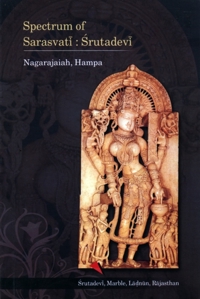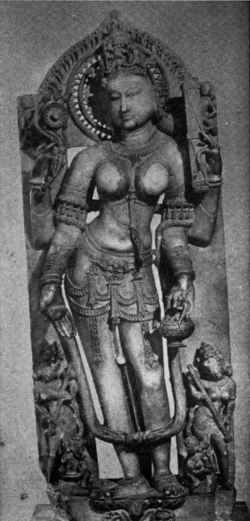 | 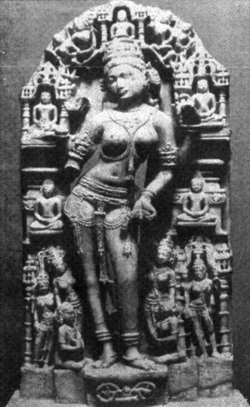 |
| [66] Pallu, 11th Century | [67] (Rajastha) British Museum |
The Śrutadevī image of white marble, chiselled to the perfection (height 1.48 m), in the National Museum, New Delhi, is an excellent specimen of Imperial Cāhamāna art. Originally procured from Pallu in Bikaner (Rajasthan), the goddess, standing gracefully on a full-bloomed lotus in traditional tribhanga stance, holds in her lean and slender fingers a sanāḷa-padma, 'full-blown lotus with stalk', a palm-leaf manuscript tied with a silken string, and water-vessel. Bedecked fully, cap-a-pie, in graiveyaka, necklaces, anklets, bracelets, armlets, wears delicately designed and embellished crown topped with a tiny figure of seated Jina. Behind the head is the somewhat stellated cut circular two-layered prabhāmaṇdala, 'lustrous round nimbus'. She wears a diaphanous sārī or sādī secured with an elaborate mekhalā, 'girdle', with pearled tassels and festoons falling on her thighs. The two female attendants elegantly standing in tribhanga in the flank and playing on vīṇā, are fully embellished. Near deity's feet are the donor couple seated on either side in namaskāra-mudrā paying homage to the goddess. The haṁsa, her mount, is shown on the pāda-pītha, 'the pedestal'. The plasticity in body and posture of this image stands in comparison to the similar superb images of Śrutadevī in the Bikaner Museum., and the other one from Lādnūn. Aesthetically these figures are unequalled.
Professor Catherine Ludvik has noticed and analysed the importance of the following rare Sarasvatī sculptures:
1. The buff sandstone Sarasvatī image (c. 6th cent.) in the Museum of Fine Arts (US: Texas - Houstan), which belonged to Uttar Pradesh (India), measures 84.2 cm and deserves description because it belongs to the early phase of surviving images. 'The lower half of Sarasvatī's body is draped with a sari, and she wears a scarf around her upper awns. Her hair is rolled up into a wide bun and adorned with an elaborate jewelled fillet. Particularly large earrings weigh down her ears, and she wears a necklace, armlets, bracelets, a waist band, and anklets. The figure is seated in lalitāsana on a lotus, playing the stick-zither, also referred to as Vina, attested from the sixth century onwards. However, the middle part of Sarasvatī's instrument is missing. Accompanying the deity are two animal-headed musicians representing Gandharvas. The ape-headed one on her lower right plays a drum, while the horse-headed one on her lower left plays a flute. Above the Gandharvas, are two Apsaras: the one on Sarasvatī's right dances, and the one on her left plays the Cymbals.
Amidst her lively entourage, Sarasvatī appears as goddess of music, playing her Vīṇa' [Ludvik 238-39].
This exceptionally extraordinary and charming image seated on viśva-padma, 'double lotus', clearly confirms that the iconographic details of Sarasvatī had taken a definite shape and were standardized by the beginning of sixth century CE. It is not definite whether it belongs to Jainism or Hinduism.
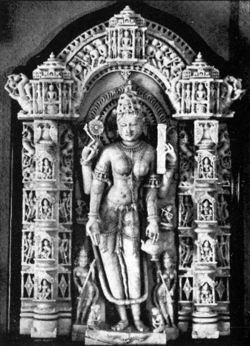 | 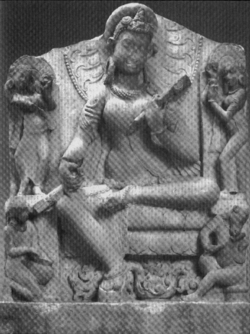 |
| [68] Bikaner Museum | [69] Museum of Fine Arts, Houston |
Singular in execution, the splendid image from Pallu (Rajasthan), National Museum, New Delhi, 11th century.
One more unequalled graceful. Jinavānimātā image opulent ornaments adorn her body, Bikaner Museum (Rajasthan).
 Prof. Dr. Nagarajaiah Hampana
Prof. Dr. Nagarajaiah Hampana
